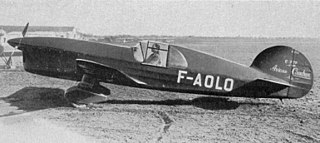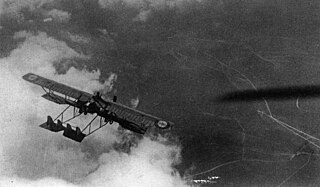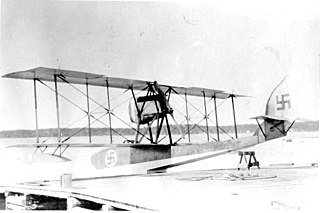
The C.710 were a series of light fighter aircraft developed by Caudron-Renault for the French Air Force just prior to the start of World War II. One version, the C.714, saw limited production, and were assigned to Polish pilots flying in France after the fall of Poland in 1939. A small number was also supplied to Finland.

The VL Humu is a Finnish fighter aircraft, designed by Valtion lentokonetehdas in 1944, and based on the American Brewster F2A Buffalo.

VL Kotka ("Eagle") was a Finnish two-seat, biplane maritime patrol aircraft, designed and built by the Valtion lentokonetehdas or VL. It was meant as a cheaper replacement for the outdated IVL A.22 Hansas that were in service with the Finnish Air Force.

Koolhoven F.K.52 was a Dutch-designed, two-seat reconnaissance-fighter biplane, which was developed in the 1930s by Koolhoven. The aircraft was equipped with an enclosed cockpit and single-strut landing gear. Only six aircraft were produced. The aircraft saw some service in the Finnish Air Force.

Jorma Kalevi Sarvanto was a Finnish Air Force pilot and the foremost Finnish fighter ace of the Winter War.

Adaridi AD 3 was a wooden aircraft designed by the Russian engineer Boris Adaridin, who lived in Finland. It was a high wing aircraft with a low-powered engine. In 1923, the Finnish Air Force ordered one Adaridi aircraft. The aircraft was not given any official designation code. The maiden flight was on April 17, 1924.

The Caudron C.59 was a French, two-seat biplane with a single engine and a canvas-covered fuselage, produced between 1922 and 1924. Suitable for a variety of roles, more than 1,800 Caudron C.59s were manufactured.

The Caudron G.3 was a single-engined French biplane built by Caudron, widely used in World War I as a reconnaissance aircraft and trainer.

The Caudron G.4 was a French biplane with twin engines, widely used during World War I as a bomber. It was designed by René and Gaston Caudron as an improvement over their single-engined Caudron G.3. The aircraft employed wing warping for banking. The first G.4 was built in 1915, and it was manufactured in France, England and Italy. It was the world's first twin-engine aircraft to be widely used, starting in March 1915.

The Thulin LA was a Swedish two-seat, single-engine biplane designed by Enoch Thulin in 1917 and made by his company AB Thulinverken in Landskrona. It was based on the earlier Thulin L and E aircraft, with a new engine, fuselage and empennage. The L and E types were in turn based on the German Albatros B.II aircraft, like the NAB Albatros. The Thulin LA was used in Sweden, the Netherlands (10) and Finland (1). This type also made the first passenger transport flights between Sweden and Denmark in 1919. Altogether there were 15 Thulin LAs built.

The Blériot-SPAD S.34 was a French twin-seat, single-engine biplane flight training aircraft designed in 1920. The side-by-side seating arrangement was unique for its time. 150 aircraft were built, 125 for the French Air Force, who used them until 1936.

The Nieuport 21 was a French single-seat, single-engine fighter aircraft used during World War I. The aircraft was used by the French, Russian, British and American air forces. After the war, the Nieuport 21 was a popular civil aircraft.

The Rumpler 6B was a German single-engine floatplane fighter with a biplane wing structure, designed and built by Rumpler Flugzeugwerke, in Berlin Johannisthal and introduced in 1916.
The Rumpler C.VIII was a German single-engine biplane advanced trainer manufactured by Rumpler Flugzeugwerke, in Berlin Johannisthal in 1917.

The SIAI Savoia S.9 was an Italian reconnaissance flying boat, manufactured by Societa Idrovolanti Alta Italia (S.I.A.I.) from 1918. The wing structure was unusual by being a single-bay biplane wing, with additional struts mounted mid-bay at the junction of the flying and landing wires, so that it appeared to have a two-bay wing. The S.9 was also licence-built in France by CAMS as the CAMS C.9.

No. 17 Replenishment Squadron, was a replenishment bomber squadron of the Finnish Air Force during World War II. The No. 17 Sqn was part of Flying Regiment 4.

Gustaf Erik Magnusson was a Finnish major general and Mannerheim Cross Knight. He was the commander of the No. 24 Squadron and Flying Regiment 3 during World War II. He also flew 158 sorties as a fighter pilot and shot down 5 1/2 enemy aircraft.

Nils Edward Katajainen was a Finnish fighter pilot and a Mannerheim Cross Knight. He held the military rank of sergeant. He flew 196 sorties and shot down 35 enemy aircraft.

The Caudron G.2 was a single-engined French biplane built by Caudron, used in World War I as a reconnaissance aircraft and trainer.





















